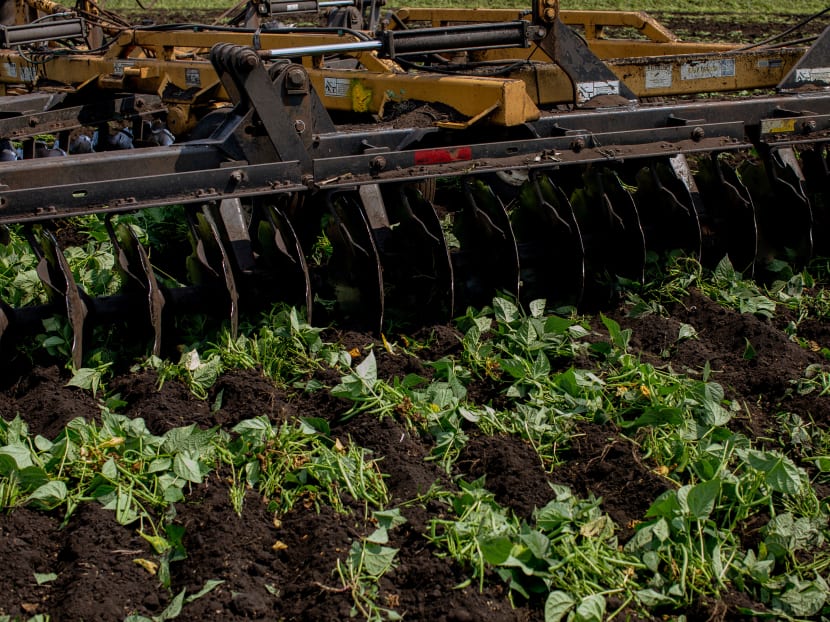The Big Read in short: What the global supply chain shock means for S’pore consumers
Each week, TODAY’s long-running Big Read series delves into the trends and issues that matter. This week, we examine the upheaval in the global supply chain and the impact on Singapore consumers. This is a shortened version of the feature.

A tractor mulches green beans at a farm in Florida, United States on April 9, 2020. Some of the largest farms in the US are being forced to destroy tens of millions of pounds of fresh food that they can no longer sell.
Each week, TODAY’s long-running Big Read series delves into the trends and issues that matter. This week, we examine the upheaval in the global supply chain and the impact on Singapore consumers. This is a shortened version of the feature, which can be found here.
SINGAPORE — Across the Causeway, hundreds of melons have been left to rot on the fields of fruit farms and tonnes more thrown in the dumpsters, since Malaysia went into a lockdown on March 18 in response to a surge in Covid-19 cases there.
Under the movement control order (MCO), fresh markets and roadside stalls have been ordered to close, so demand for fresh produce has dropped dramatically, farmers told TODAY.
Malaysian fruit farmer Toh Lee Chew said orders for his melons are down 50 to 70 per cent. Unable to find other ways to sell them, he has left the melons to rot in the fields.
His brother Toh Lee Bing, who helps supply the fruits to markets and fruit stallholders, said he has had to throw away 3 to 4 tonnes of fruits from every lorry, even after donating whatever he can to charities.
The dumping of excess agricultural produce due to a drastic drop in demand as restaurants, hotels and other food outlets close is happening not just in Malaysia.
In the United States, the New York Times reported that farmers have had to dump thousands of gallons of fresh milk into lagoons, while Reuters reported that farmers in India are throwing truckloads of fresh grapes into compost heaps.
The pictures in the media reports showing staggering amounts of agricultural waste stand in stark contrast to images of empty shelves and snaking queues in supermarkets in various parts of the world, where buying limits on groceries have also been imposed to prevent hoarding.
This disconnect between supply and demand is the result of global food supply chains being disrupted in unprecedented ways, as governments impose lockdowns to curb the spread of the highly infectious novel coronavirus that causes the Covid-19 disease.
The supply chain disruption could have been much worse. Thankfully, China — the world’s second largest economy — had recently eased restrictions gradually all over the country and lifted the nearly three-month lockdown in Wuhan, where the Covid-19 pandemic started.
Still, as many countries turn to China for their supplies, the capacity of China’s containers and ports would limit the amount of food that can be exported at any one time, NTUC FairPrice chief executive officer Seah Kian Peng told TODAY.
SAFETY NETS IN PLACE BUT…
Despite the upheavals, experts stressed that there are enough non-perishables, such as rice and wheat, to feed the world.
According to the US Department of Agriculture, global stockpiles of rice this year are at an all-time high of more than 180 million tonnes, with global production estimated to be at around a record 500 million tonnes for 2019 and 2020.
For the next few months, the existence of national stockpiles also means that there will be enough food to go around, such as in Singapore’s case.
In response to queries from TODAY, a spokesperson from the Ministry of Trade and Industry (MTI) said that Singapore has a “robust and multi-pronged strategy” to ensure the resilience of its food and essential supplies.
“This includes prudent stockpiling and diversification of sources, and also the expansion of local production,” the spokesperson said.
The ministry is also working with like-minded countries to ensure that supply chains remain intact as much as possible even while countries implement their own domestic plans to address the pandemic.
Long before Covid-19 hit the nation’s shores, Singapore had already planned for food supply disruptions by putting in place a comprehensive strategy after the food crisis of 2007 and 2008. That was when global prices of food shot up dramatically due to trade shocks, rising oil prices and food stocks diverted to produce biofuels.
Despite the best-laid plans, government policies to diversify food sources are premised on the fact that there is no generalised crisis, so that even if there are stoppages in one country, supply lines are still intact in another, said Professor Paul Teng, an adjunct senior fellow at the Centre for Non-Traditional Security Studies in the S Rajaratnam School of International Studies.
“The world is not prepared for a generalised crisis (like Covid-19),” he pointed out.
Beyond the stockpiles, some supply shortages could happen globally in the next few months, said experts and industry players.
With farmers and workers staying home either due to movement curbs or fears of being infected with Covid-19, the normal production capacities of farms and food processing factories have been reduced.
Mr David Tan, president of the Singapore Food Manufacturers’ Association (SFMA), said food importers here are worried that lockdowns in Thailand, Vietnam and Myanmar might affect the operating capacity of farms in these countries, and eventually its yields.
SUPPLY-DEMAND DISCONNECT
The more complex problem though, experts say, is the disconnect between supply and demand.
Supply and demand for food is not fully synchronised and there will always be a time lag, which is why supplies cannot move fast enough to keep up with the drastic changes in demand due to the pandemic, said Prof Teng,
A lot of food that has been dumped was grown for the purpose of supplying to the food and beverage (F&B) industry, hotels, schools and airports — all of which saw a sudden sharp drop in demand when lockdowns and border closures were imposed.
Because of this time lag, food is being produced based on old production schedules, said Mr Mr Alex Capri, senior fellow at the National University of Singapore (NUS) Business School.
Many farmers end up not being able to move these items to where demand has shifted to, that is, supermarkets and consumers. “You are going to have a surplus and the food is going to end up not going where it needs to go,” he added.
The problem is further compounded by the reliance on traditional transportation links, such as air and sea, which have been severely disrupted as global trade and air travel grind to a halt.
HOW AFFECTED S’PORE WHOLESALERS ARE ADAPTING
Distributors interviewed by TODAY have had to cut down the volume of supplies imported into Singapore, look for new sources and in one case, totally transform their business model in response to the fast-changing situation.
While demand from supermarkets is surging, demand from hotels, restaurants and other food services is down 50 to 80 per cent, said SFMA’s Mr Tan.
“This is also causing a lot of unbalanced demand,” he added.
With 80 per cent of his food products imported from Malaysia, Mr Anthony Lee, manager of Yee Lee Oils and Foodstuffs, said his company has not been able to receive his stocks in time, causing him to cancel some earlier orders from minimarts and supermarkets.
His company brings in packaged food items — such as instant noodles, cooking oil, mineral water, canned food, curry paste, and some sauces — and distributes them to hotels, restaurants and offices, as well as supermarkets.
“The demand suddenly switched… I can’t react because normally we forecast three months ahead. The change is too fast. I don’t know how to manage,” said Mr Lee.
While the majority (55 per cent) of his stock used to be for the F&B sector and hotels, now up to 75 per cent goes to supermarkets.
For Mr Justin Chou, chief executive officer of Glife, the sudden disruption meant that he had to quickly change his company’s business model — from supplying fresh vegetables, fruits and eggs to the F&B sector through e-commerce, to selling directly to consumers.
From fulfilling 35 orders on the first day, his company now has to fulfil over 100 orders every day and they are looking to increase the delivery slots to more than 200 next week.
“Last time I delivered to shopping centres. Now I go to neighbourhood estates,” said Mr Chou.
SFMA’s Mr Tan said that food transported via air used to be able to piggyback on passenger flights which have now been almost obliterated.
“Goods flown into Singapore are facing a drastic increase in freight charges as they have to especially engage planes to fly in provisions,” he noted.
Lockdowns worldwide have also led to delays at ports and a shortage of containers, Mr Tan said, contributing to higher logistics costs for food supplies brought in by sea.
Wholesalers say that the costs they incur in bringing food into Singapore have gone up due to an increase in transportation charges. Mr Chou estimates his costs to have gone up by about 30 per cent.
IMPACT ON S’PORE CONSUMERS
The disruption in the food supply chains and the increase in logistics cost would translate to higher food prices for consumers in Singapore.
Already, prices of certain food items, such as threadfin and squid, have increased by 40 per cent, shoppers told TODAY.
Mrs Jade Sng, who shops at the wet market and FairPrice every weekend for her groceries said that the price of eggs has gone up from S$3.90 for 30 eggs to S$5.50.
One kilogram of onions used to cost about S$2 but it is now about S$4.50.
To help Singapore consumers, FairPrice’s Mr Seah said that Singapore's largest supermarket chain would keep its pledge made in March last year to freeze the prices of 100 FairPrice house brand products including rice, cooking oil, poultry and toiletries, till the middle of this year.
Mr Seah said consumers would have to adjust and accept the fact that they may not be able to get their favourite brand of eggs, for example.
Some shoppers like Mrs Sng have already started to make some adjustments.
Mrs Sng said that while she used to buy russet potatoes from the US, their price has gone up from S$2.50 to S$4.50 for 1kg.
She has turned to cheaper potatoes from Bangladesh that cost slightly over S$1 for 1kg. But these are not as good as the russet potatoes for making mashed potatoes, she noted.
“I probably won’t eat mashed potatoes for a while,” said the 66-year-old lecturer.








